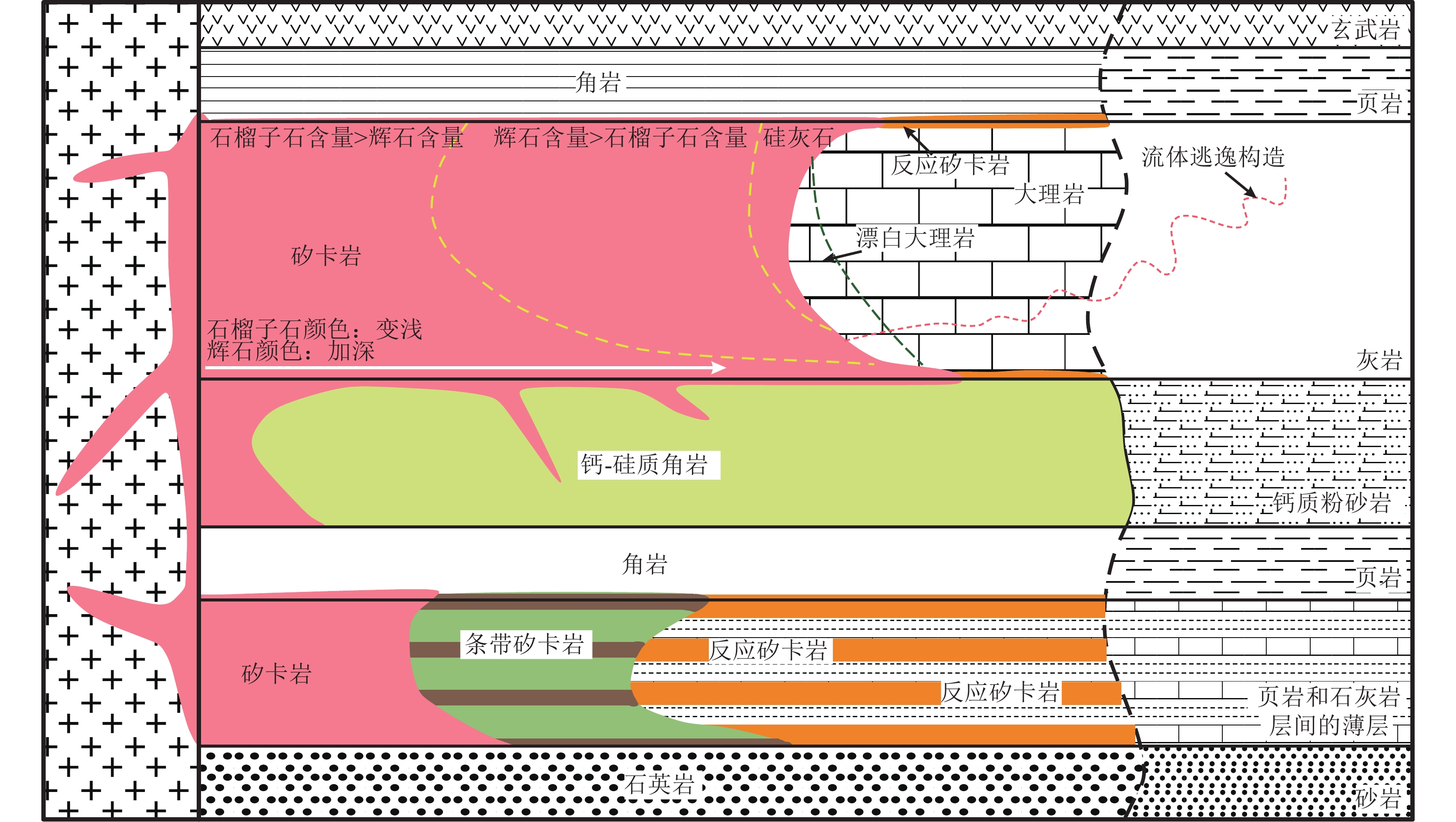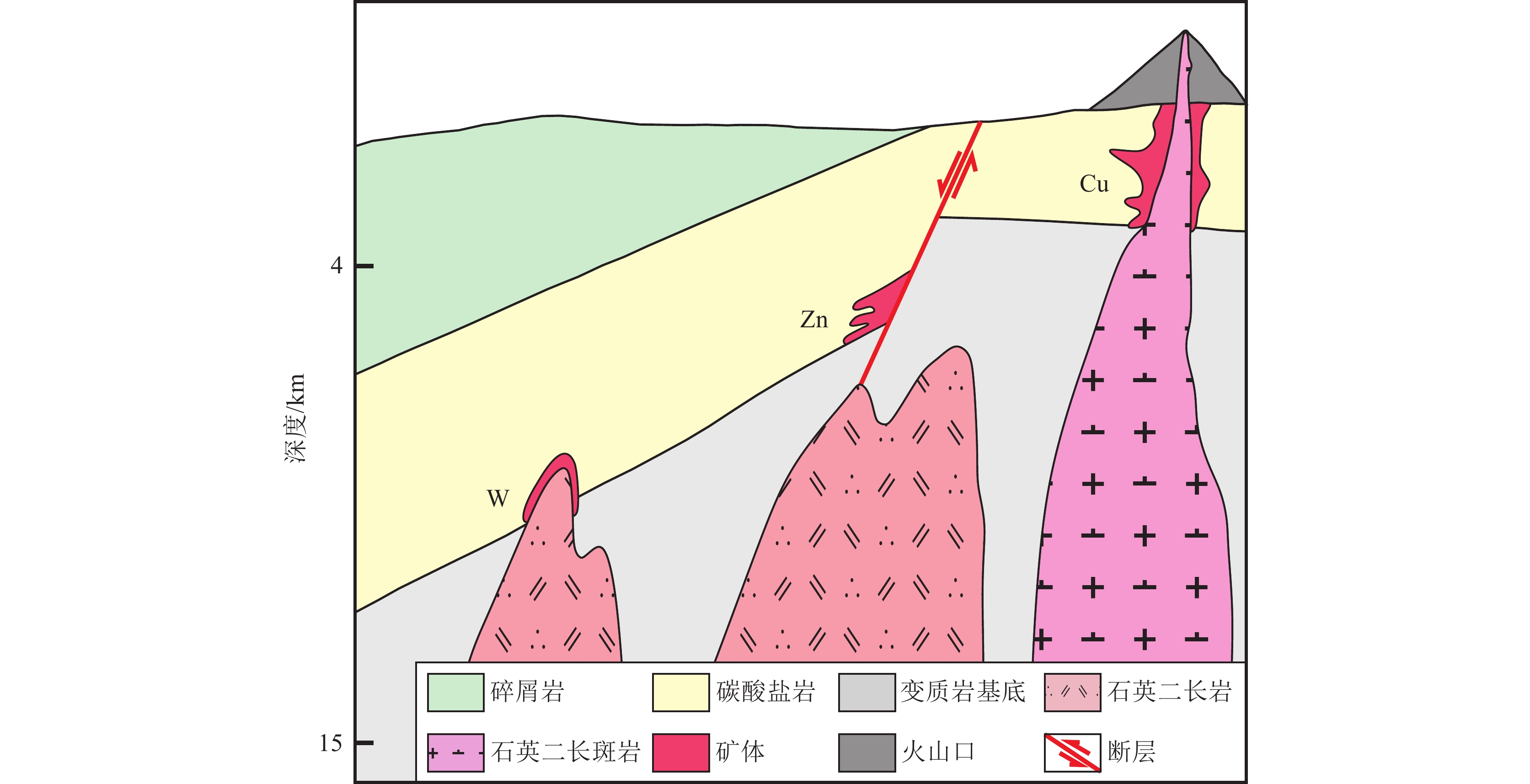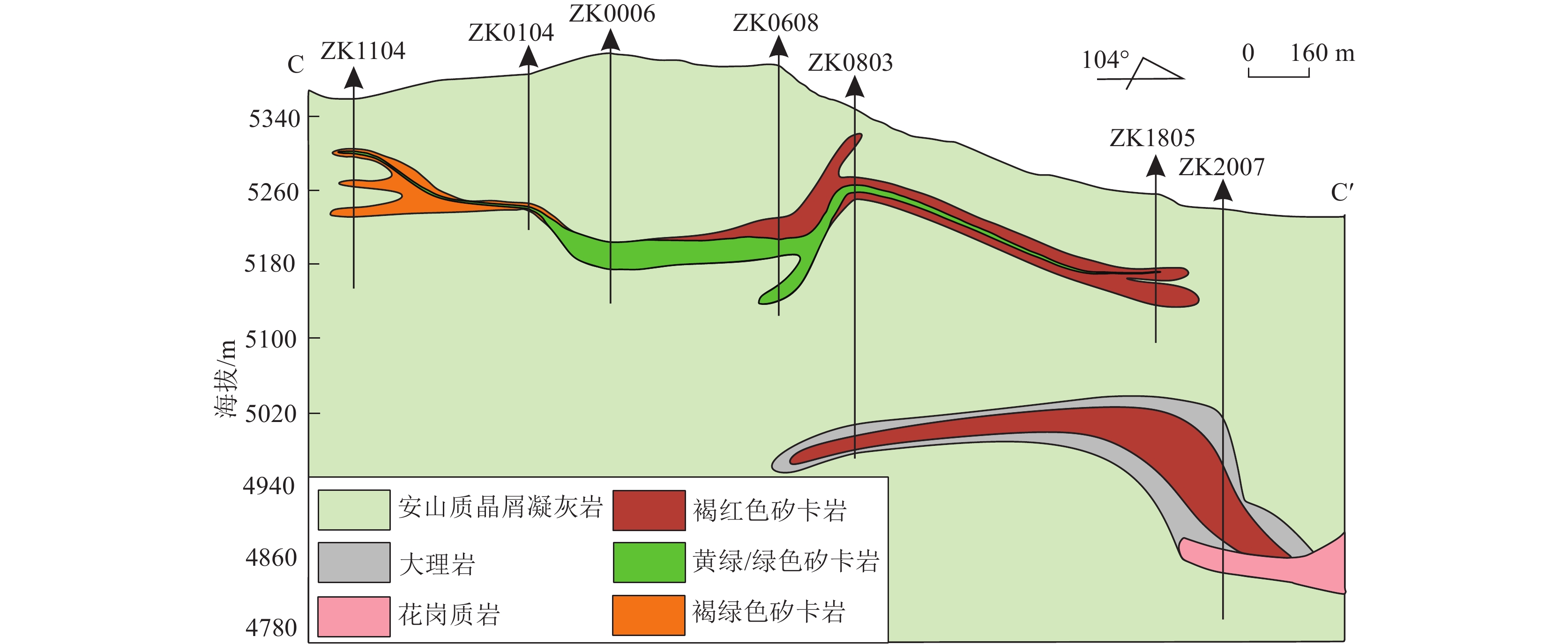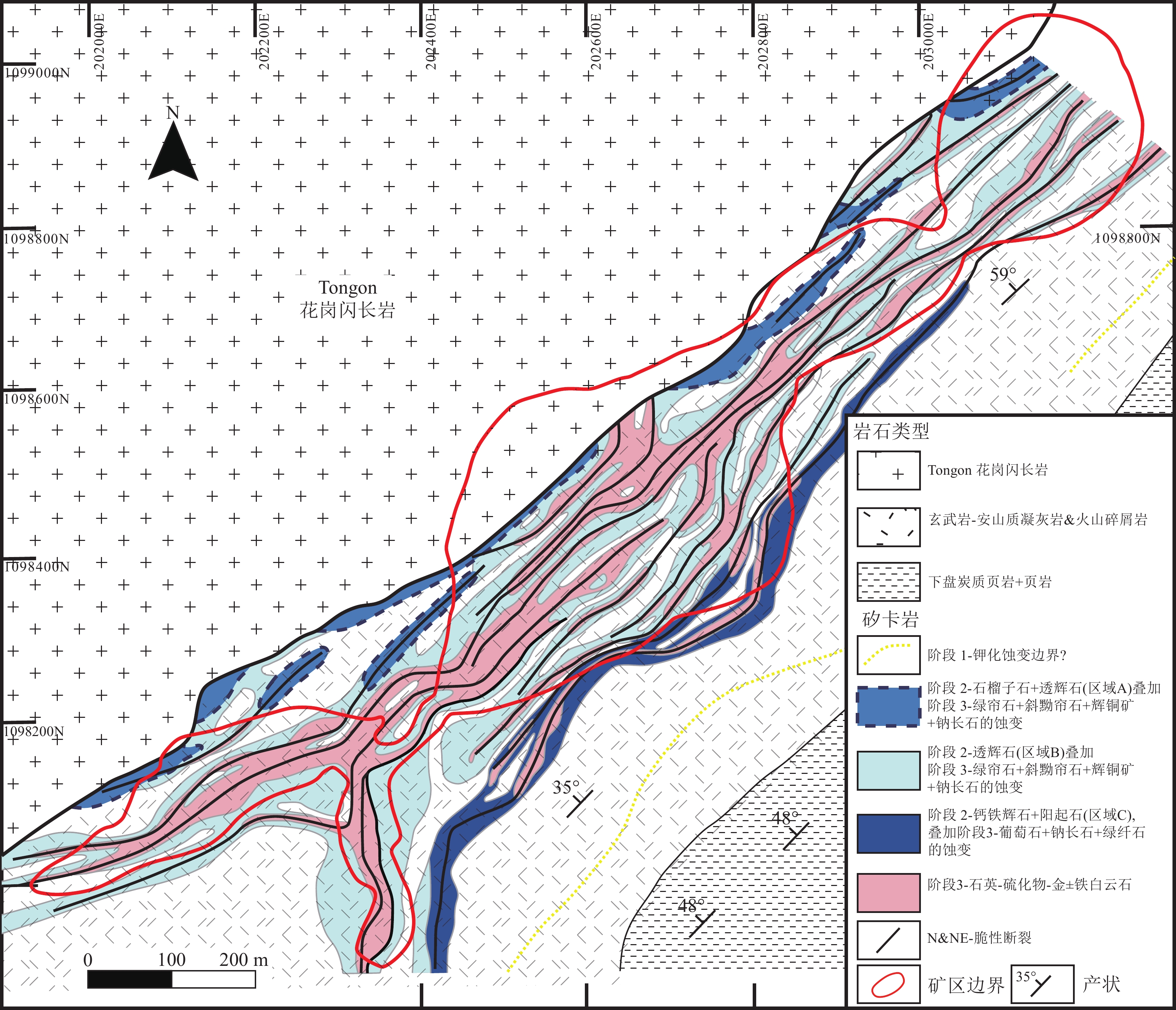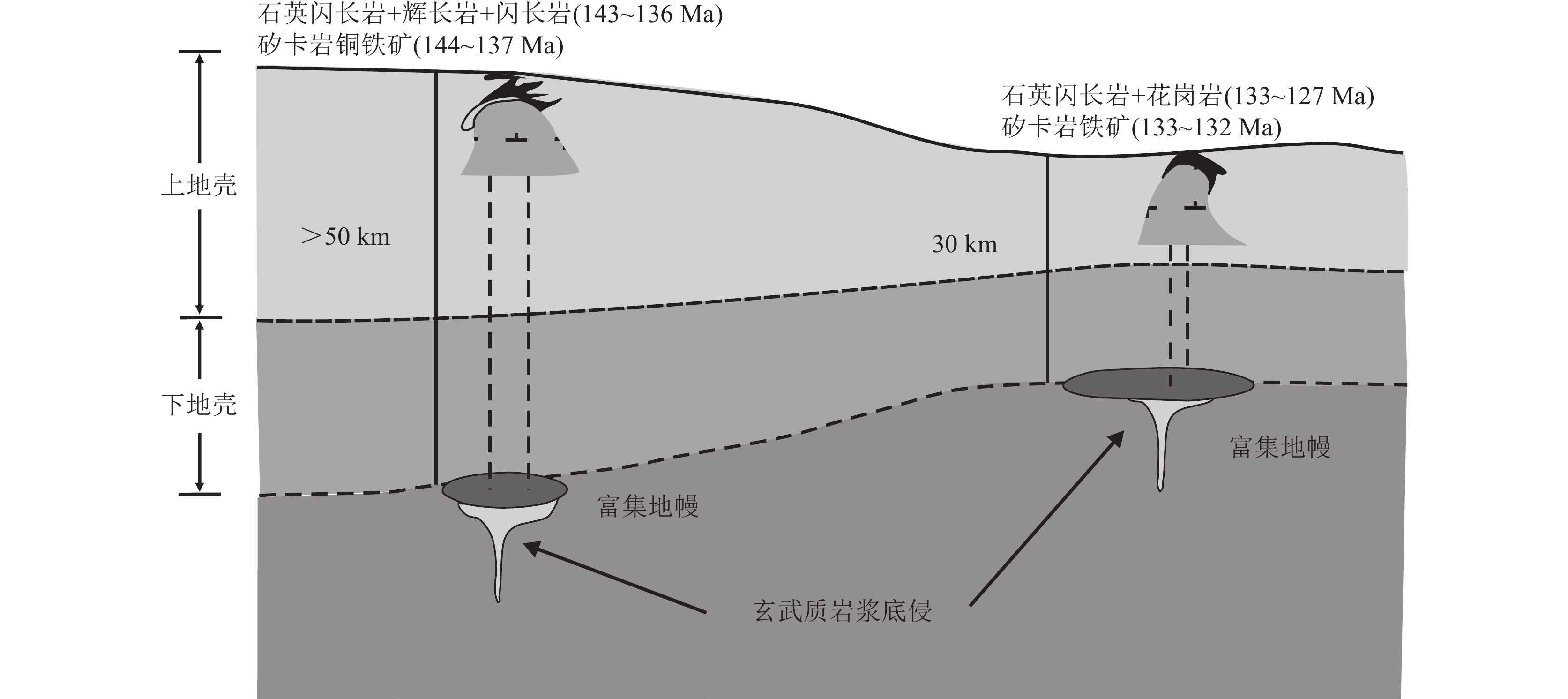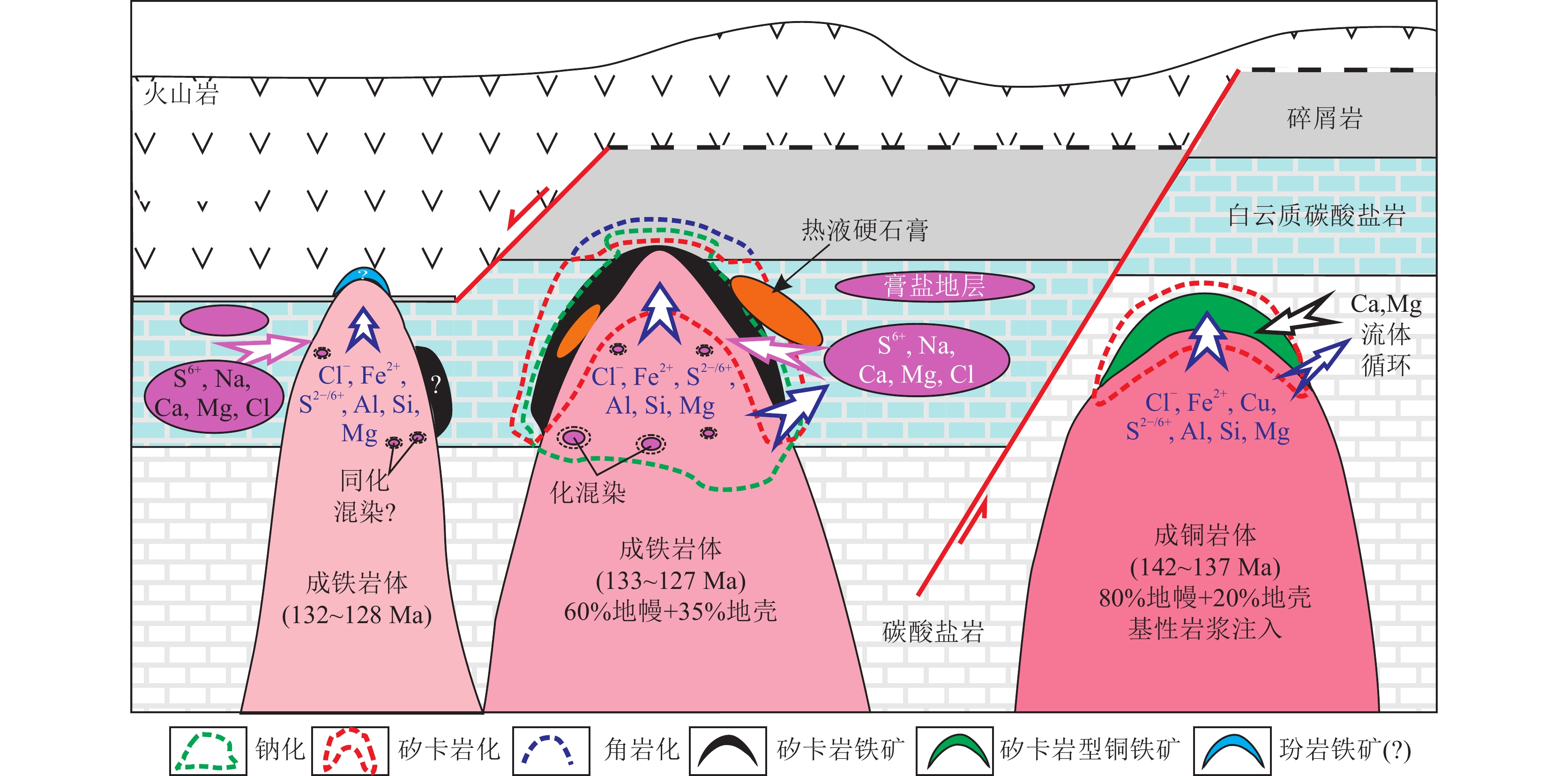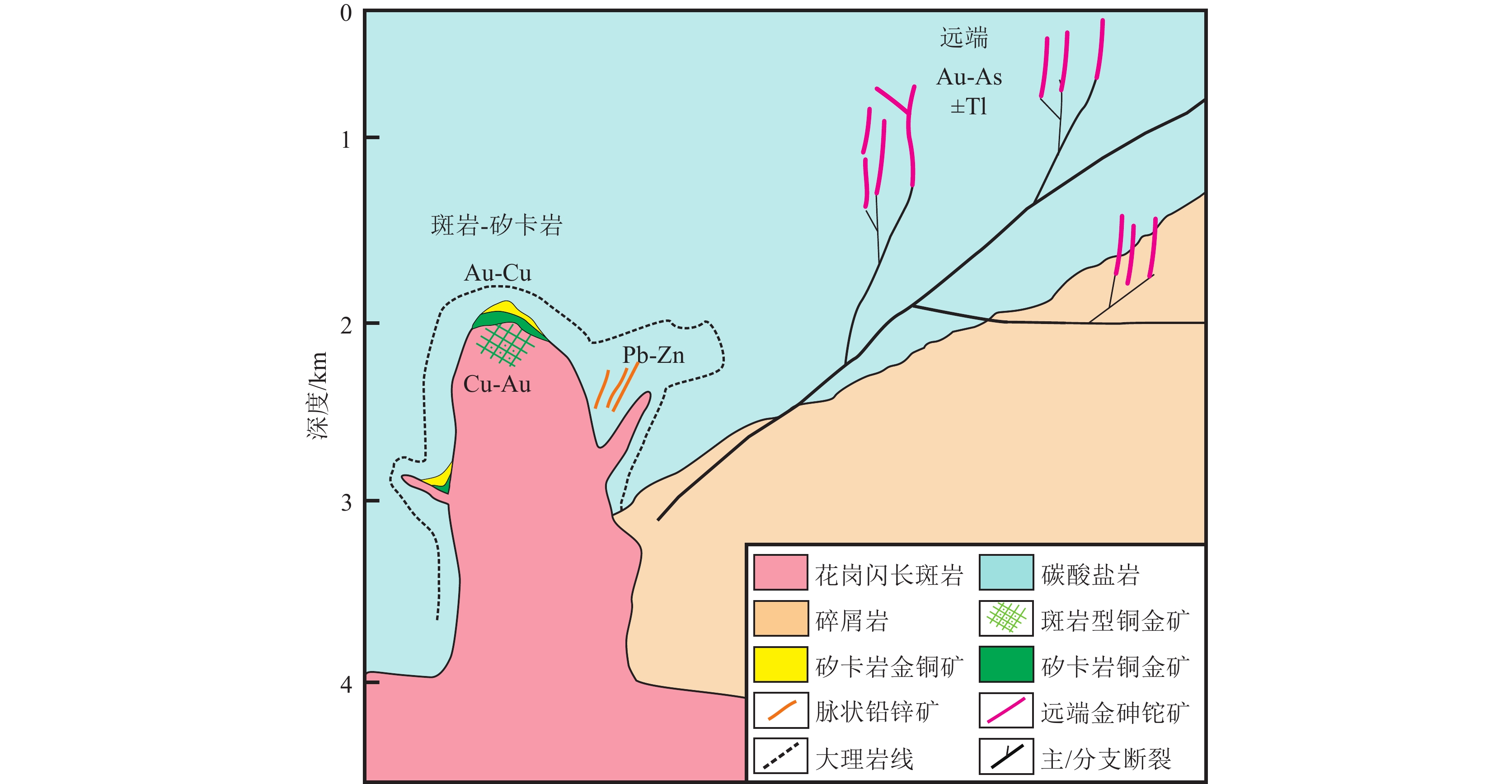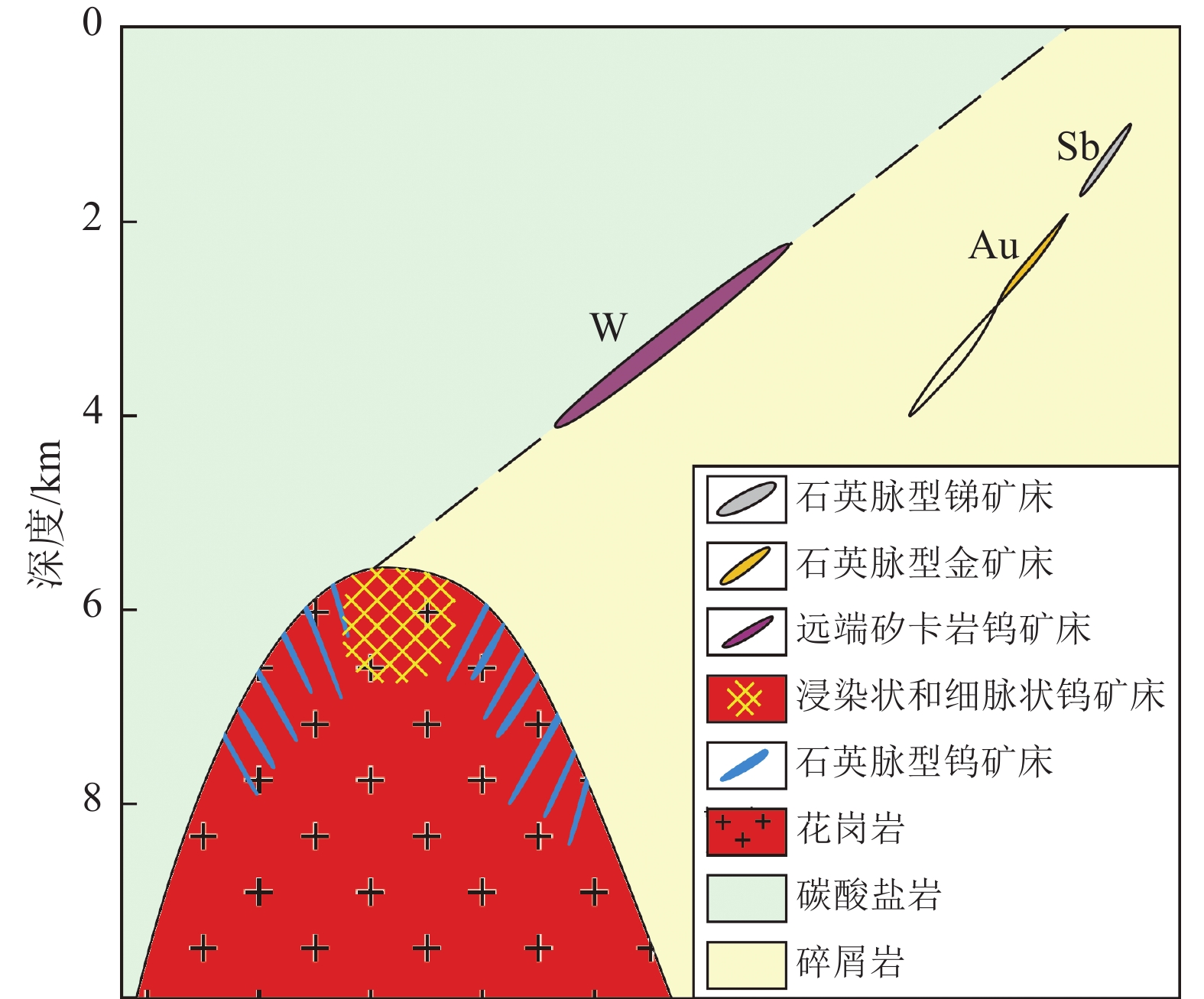Research on skarn deposit models
-
摘要:
研究目的 矽卡岩矿床是地壳中最丰富的矿床类型之一,是中国多数成矿区带的主攻找矿类型之一。矿床模型不仅用于刻画成矿理论,而且可以用于指导找矿勘查,是评价未发现矿床的重要技术方法,因此,矽卡岩矿床的矿床模型一直受到高度关注,但系统总结近年研究进展相对薄弱。
研究方法 全面收集国内外矽卡岩矿床的资料,结合笔者长达20余年的研究成果,综合分析矽卡岩矿床模型的研究进展。
研究结果 叙述全球矽卡岩矿床的研究历史和主要类型,总结矽卡岩矿床的矿物组合和分带模式及其控制因素,综述与斑岩有关的矽卡岩铜多金属矿床、远成矽卡岩矿床和交代火成岩矽卡岩矿床的研究现状。以中国长江中下游和江南造山带中段湘中地区矽卡岩矿床为对象,从成矿系统角度,构建氧化性矽卡岩铜铁金矿床组合模型和还原性矽卡岩钨金锑矿床组合模型。
结论 两组成矿系统矿床模型拓宽了找矿方向,展望了矽卡岩矿床模型未来研究方向,为新一轮找矿突破战略行动提供借鉴和参考。
Abstract:Objective Skarn deposits are one of the most abundant types of ore deposit in the Earth's crust and are a major target for mineral exploration in many metallogenic belts across China. Deposit models serve as graphical representations of metallogenic theories and as indispensable tools for guiding exploration efforts and assessing undiscovered mineral resources. Therefore, the deposit model of skarn deposits has received significant attention. However, systematic summaries of recent research progress are relatively limited.
Methods A comprehensive collection of domestic and international data on skarn deposits is undertaken, combined with the author’s over 20 years of research, to analyze the progress of research on skarn deposit models.
Results The study outlines the global research history and primary types of skarn deposits, summarizes their mineral assemblages, zoning patterns, and controlling factors, and reviews the current state of research on skarn copper−polymetallic deposits associated with porphyry systems, distal skarn deposits, and those formed by the alteration of igneous rocks. This study uses skarn deposits from the Middle to Lower Yangtze River region and the middle section of the Jiangnan Orogenic Belt in China as a case study to develop two metallogenic models: an oxidative skarn copper−iron−gold deposit model and a reductive skarn tungsten−gold−antimony deposit model.
Conclusions These two metallogenic system deposit models broaden the direction of mineral exploration, provide insights into future research on skarn deposit models, and offer references for breakthroughs in exploration strategies.
-
Key words:
- skarn deposits /
- mineral assemblage /
- zoning patterns /
- mineral deposit models /
- metallogenic systems
-

-
图 1 全球矽卡岩矿床分布图(据赵一鸣等,2023修改)
Figure 1.
图 2 中国主要矽卡岩矿床分布图(据Chang et al., 2019修改)
Figure 2.
图 3 不同类型矽卡岩矿床比例(据赵一鸣等,2023;Chang et al., 2019修改)
Figure 3.
图 4 不同类型矽卡岩矿床石榴子石和辉石成分三角图解(据Meinert, 1992修改)
Figure 4.
图 5 矽卡岩矿床矽卡岩矿物组合和硫化物分带(据Chang et al., 2019修改)
Figure 5.
图 6 矽卡岩钨、铜和锌矿床的形成深度(据Newberry and Einaudi, 1981修改)
Figure 6.
图 7 西藏知不拉矽卡岩铜矿床CC’剖面石榴子石颜色分带(据王天语等,2024修改)
Figure 7.
图 8 斑岩-矽卡岩-碳酸盐交代-卡林型矿床组合模型(据Sillitoe, 2020修改)
Figure 8.
图 9 东秦岭板厂矽卡岩铜钼+碳酸盐岩交代铅锌银矿床组合模型(据Li et al., 2024修改)
Figure 9.
图 10 科特迪瓦北部Tongon超大型矽卡岩金矿床剖面图(据Lawrence et al., 2017修改;矿体产于玄武岩-安山岩结晶凝灰岩中受构造控制的矽卡岩)
Figure 10.
图 11 加拿大不列颠哥伦比亚省Merry Widow(a)和Iron Hill(b)矽卡岩铁矿床剖面图(据Meinert, 1984修改;矿体主要产于火山岩中)
Figure 11.
图 12 鄂东矿集区两期矽卡岩铜铁多金属矿床模型(据谢桂青等,2016修改)
Figure 12.
图 13 鄂东矿集区矽卡岩铜铁矿床+膏盐层成矿系统矿床模型(据谢桂青等,2025修改)
Figure 13.
图 14 长江中下游氧化性岩浆有关的斑岩-矽卡岩铜金矿床+远成低温金矿床组合模型(据Xie et al., 2019b修改)
Figure 14.
图 15 鄂东南和湘中地区含矿岩体的氧化还原条件(原始数据来源于Wang et al., 2007, 2012, 2015; 陈卫峰等, 2007; Qiu et al., 2014; Xu et al., 2014; 刘凯等, 2014; Xie et al., 2015; 柏道远等, 2016)
Figure 15.
图 17 华南地区三叠纪矿床分带模型(据谢桂青等,2021修改)
Figure 17.
-
[1] Atkinson W W Jr, Einaudi M T. 1978. Skarn formation and mineralization in the contact aureole at Carr Fork, Bingham, Utah[J]. Economic Geology, 73: 1326−1365. doi: 10.2113/gsecongeo.73.7.1326
[2] Bai D H, Wu N J, Zhong X, et al. 2016. Geochronology, Petrogenesis and tectonic setting of Indosinian Wawutang granites, Southwestern Hunan Province[J]. Geotectonica et Metallogenia, 40: 1075−1091(in Chinese with English abstract).
[3] Burt D M. 1982. Skarn deposits−Historical bibliography through 1970[J]. Economic Geology, 77: 755−763. doi: 10.2113/gsecongeo.77.4.755
[4] Chang Y F, Liu X G. 1983. On strata−bound skarn deposits[J]. Mineral Deposits, 2(1): 11−20 (in Chinese with English abstract).
[5] Chang Z S, Meinert L D, Lawrence D M, et al. 2018. Skarns replacing igneous rocks[C]//15th Quadrennial IAGOD Symposium, Salta, Argentina, 28−31 August: 207−208.
[6] Chang Z S, Mrozek S, Meinert L D, et al. 2015. Skarn−porphyry transition: An example from the Antamina skarn, Peru[C]//Proceedings of PACRIM, AusIMM PACRIM Congress, 18−21 March 2015, Hong Kong, China: 409−413.
[7] Chang Z S, Shu Q H, Meinert L D. 2019. Skarn deposits of China[M]. SEG Special Publications, 22: 189−234.
[8] Chang Z S. 2021. Skarn: Zoning patterns and controlling factors[C]//The 13th MGRI Annual Convention, Jakarta, 14−16 December: 19−25.
[9] Chen W F, Chen P R, Huang H Y, et al. 2007. Chronological and geochemical studies of granite and enclave in Baimashan pluton, Hunan, South China[J]. Science in China (Series D), 50(11): 1606−1627(in Chinese with English abstract). doi: 10.1007/s11430-007-0073-1
[10] Chen Y J, Chen H Y, Zaw K, et al. 2007. Geodynamic settings and tectonic model of skarn gold deposits in China: an overview[J]. Ore Geology Reviews, 31: 139−169. doi: 10.1016/j.oregeorev.2005.01.001
[11] Einaudi M T, Burt D M. 1982. Introduction−Terminology, classification, and composition of skarn deposits[J]. Economic Geology, 77: 745−754.
[12] Einaudi M T, Meinert L D, Newberry R J. 1981. Skarn deposits[J]. Economic Geology, 75th Anniversary Volume: 317−391.
[13] Einaudi M T. 1982. General features and origin of skarns associated with porphyry copper plutons[C]//Titley S R. Advances in Geology of the Porphyry Copper Deposits, Southwestern U. S. Arizona: Univ. Arizona Press: 185−209.
[14] Ettlinger A D, Meinert L D, Ray G E. 1992. Gold skarn mineralization and fluid evolution in the Nickel Plate deposit, Hedley District, British Columbia[J]. Economic Geology, 87: 1541−1565. doi: 10.2113/gsecongeo.87.6.1541
[15] Gaspar L M, Inverno C M C. 2000. Mineralogy and metasomatic evolution of distal strata−bound scheelite skarns in the Riba de Alva Mine, Northeastern Portugal[J]. Economic Geology, 95: 1259−1275.
[16] Graybeal F T. 2022. Aspects of mineral exploration thinking[J]. SEG Discovery, 128: 24−35.
[17] Hart C J R. 2007. Reduced intrusion−related gold systems[M]. Geological Association of Canada, Mineral Deposits Division Special Publication, 5: 95−112.
[18] Hosseini Z, Swennen R, Mahboubi A, et al. 2022. Stylolites (re)activation: A factor in fluid flow and ore emplacement of Irankuh[J]. Sedimentary Geology, 431: 106108. doi: 10.1016/j.sedgeo.2022.106108
[19] Hou Z D, Zhao Z, Xu Y M, et al. 2024. Exploration model and deep prospecting prediction of Jiepailing tin−fluorite deposit in Hunan Province, China[J]. Mineral Deposits, 43(1): 128−143(in Chinese with English abstract).
[20] Hu R Z, Yan P L, Qiu L, et al. 2021. Large scale low−temperature metallogenesis in south China[M]. Beijing: Science Press: 1−468(in Chinese).
[21] Huang K, Xie G Q, Duan L A, et al. 2022. Identification of Paodaoling large intermediate−sulfidation epithermal gold deposit in Middle−Lower Yangtze River Valley metallogenic belt and its implication for mineral exploration[J]. Mineral Deposits, 41(2): 440−448 (in Chinese with English abstract).
[22] Huang Y, Pei R F, Ren G Z, et al. 1957. On the Daye−type iron deposit[J]. Acta Geologica Sinica, 37(2): 191−202(in Chinese with English abstract).
[23] Jinari A, Rddad L, Mouguina E M, et al. 2023. Origin of the Amensif Zn−Cu (Pb−Ag−Au) distal skarn deposit (Western High Atlas, Morocco): Constraints from C−O−S isotopes[J]. Journal of African Earth Sciences, 199: 104850. doi: 10.1016/j.jafrearsci.2023.104850
[24] Kwak T A P, White A J R. 1982. Contrasting W−Mo−Cu and W−Sn−F skarn types and related granitoids[J]. Mineralium Deposita, 32: 339−351.
[25] Kwak T A P. 1987. W−Sn skarn deposits and related metamorphic skarns and granitoids[M]. Elsevier: 1−451.
[26] Kyle J R, Rubin J N, McMahon T P, et al. 1991. Preliminary investigations of porphyry−skarn copper−gold orebodies, Ertsberg district, Irian Jaya, Indonesia[C]//Geological Society of Canada, Abstracts with Program, 16: A69.
[27] Lawrence D M, Allibone A H, Chang Z S, et al. 2017. The Tongon Au deposit, Northern Cote d’Ivoire: An example of Paleoproterozoic Au skarn mineralization[J]. Economic Geology, 112: 1571−1593. doi: 10.5382/econgeo.2017.4522
[28] Li W, Xie G Q, Mao J W, et al. 2018. Muscovite 40Ar/39Ar and in situ sulfur isotope analyses of the slate−hosted Gutaishan Au–Sb deposit, South China[J]. Ore Geology Reviews, 101: 839−853. doi: 10.1016/j.oregeorev.2018.08.006
[29] Li Z Y, Xie G Q, Li S L, et al. 2024. Geology and geochronology of the Banchang distal Cu−Mo skarn deposit, Central China[J]. Mineralium Deposita, 59: 1185−1205. doi: 10.1007/s00126-024-01256-5
[30] Lindgren W. 1933. Mineral Deposits[M]. McGraw−Hill: 1−930.
[31] Liu K, Mao J R, Zhao X L, et al. 2014. Geological and geochemical characteristics and genetic significance of the Ziyunshan pluton in Hunan province[J]. Acta Geologica Sinica, 88: 208−227(in Chinese with English abstract). doi: 10.1111/1755-6724.12269_5
[32] Liu Y J, Cao L M, Li Z L, et al. 1984. Element geochemistry[M]. Beijing: Science Press: 1−548(in Chinese).
[33] Mao J W, Liu M, Yao F J, et al. 2024. Some points concerned in field of prospecting and exploration in China and future considerations[J]. Mineral Deposits, 43: 1211−1222(in Chinese with English abstract).
[34] Megaw P K M. 1998. Carbonate−hosted Pb−Zn−Ag−Cu−Au replacement deposits[C]// Lentz D R. Mineralized Intrusion−Related Skarn Systems. Mineral Association of Canada, Short Course, 26: 337−357.
[35] Meinert L D, Dipple G M, Nicolescu S. 2005. World skarn deposits[J]. Economic Geology, 100th Anniversary Volume: 299−336.
[36] Meinert L D. 1983. Variability of skarn deposits: Guides to exploration[C]//Boardman S J. Revolution in the earth sciences. Dubuque, Iowa, Kendall−Hunt, 301−316.
[37] Meinert L D. 1984. Mineralogy and petrology of iron skarns in western British Columbia, Canada[J]. Economic Geology, 79: 869−882. doi: 10.2113/gsecongeo.79.5.869
[38] Meinert L D. 1989. Gold skarn deposits—Geology and exploration criteria[J]. Economic Geology Monograph, 6: 537−552.
[39] Meinert L D. 1992. Skarns and skarn deposits[J]. Geoscience Canada, 19: 145−162.
[40] Meinert L D. 2020. Geology, policy, and wine—the intersection of science and life[J]. Geochemical Perspectives, 9: 1−133.
[41] Mrozek S, Chang Z, Spandler C, et al. 2020. Classifying skarns and quantifying metasomatism at the Antamina deposit, Peru: Insights from whole−rock geochemistry[J]. Economic Geology, 115: 177−188. doi: 10.5382/econgeo.4698
[42] Nakano T, Yoshino T, Shimazaki H, et al. 1994. Pyroxene composition as an indicator in the classification of skarn deposits[J]. Economic Geology, 89: 1567−1580. doi: 10.2113/gsecongeo.89.7.1567
[43] Newberry R J, Einaudi M T. 1981. Tectonic and geochemical setting of tungsten skarn mineralization in the Cordillera[J]. Arizona Geological Society Digest, 14: 99−112.
[44] Pei R F, Liu Y, Lü F X. 1985. The rediscussion about Daye iron deposits[C]//Collector of institute of mineral deposits, Chinese Academy of Geological Sciences. Beijing: Geological Society of China, (3): 1−11(in Chinese).
[45] Peng J T. 2019. The first discovery of tungsten orebodies with high ore grades in the Xingfengshan gold deposit, Longhui County, Hunan Province[J]. Geological Reviews, 65(3): 664−670 (in Chinese with English abstract).
[46] Qiu L, Yan D P, Zhou M F, et al. 2014. Geochronology and geochemistry of the Late Triassic Longtan pluton in South China: Termination of the crustal melting and Indosinian orogenesis[J]. International Journal of Earth Sciences, 103: 649−666. doi: 10.1007/s00531-013-0996-z
[47] Shu Q H, Deng J, Chang Z S. 2024. Skarn zonation of the giant Jiama Cu−Mo−Au deposit in southern Tibet, SW China[J]. Economic Geology, 119: 1−22. doi: 10.5382/econgeo.5038
[48] Sillitoe R H. 2010. Porphyry copper systems[J]. Economic geology, 105: 3−41. doi: 10.2113/gsecongeo.105.1.3
[49] Sillitoe R H. 2020. Carlin−type and distal−disseminated gold deposits: a carbonate−replacement deposit perspective[C]//Koutz F R, Pennell W M. Vision for discovery: Geology and ore deposits of the basin and Range. v. 2. Geological Society of Nevada, Reno: 1055–1074.
[50] Sillitoe R H. 2024. Metallogeny and mineral exploration—Some personal reminiscences[J]. Geochemical Perspectives, 13: 1−196.
[51] Soloviev S G, Kryazhev S G, Dvurechenskaya S S. 2020. Geology, mineralization, and fluid inclusion characteristics of the Agylki reduced tungsten (W−Cu−Au−Bi) skarn deposit, Verkhoyansk fold−and−thrust belt, Eastern Siberia[J]. Ore Geology Reviews, 120: 103452. doi: 10.1016/j.oregeorev.2020.103452
[52] Song S W, Mao J W, Xie G Q, et al. 2021. The world−class mid−Mesozoic Jiangnan tungsten belt, South China: Coeval large reduced and small oxidized tungsten systems controlled by different magmatic petrogenesis[J]. Ore Geology Reviews, 139: 104543. doi: 10.1016/j.oregeorev.2021.104543
[53] Thompson J F H, Sillitoe R H, Baker T, et al. 1999. Intrusion−related gold deposits associated with tungsten−tin provinces[J]. Mineralium Deposita, 34: 323−334. doi: 10.1007/s001260050207
[54] Wang K X, Chen W F, Chen P R, et al. 2015. Petrogenesis and geodynamic implications of the Xiema and Ziyunshan plutons in Hunan Province, South China[J]. Journal of Asian Earth Sciences, 111: 919−935. doi: 10.1016/j.jseaes.2015.08.017
[55] Wang K X, Chen P R, Chen W F, et al. 2012. Magma mingling and chemical diffusion in the Taojiang granitoids in the Hunan Province, China: Evidences from petrography, geochronology and geochemistry[J]. Mineralogy and Petrology, 106: 43−264.
[56] Wang T Y, Xie G Q, Zuo J Z, et al. 2024. Thermal infrared spectral characteristics of garnet in the Zhibula Cu skarn deposit, Xizang, and their implications for mineral exploration[J]. Geotectonica et Metallogenia, 48: 1330−1343(in Chinese with English abstract).
[57] Wang Y, Fan W, Sun M, et al. 2007. Geochronological, geochemical and geothermal constraints on petrogenesis of the Indosinian peraluminous granites in the South China Block: A case study in the Hunan Province[J]. Lithos, 96: 475−502. doi: 10.1016/j.lithos.2006.11.010
[58] Williams−Jones A E, Samson I M, Ault K M, et al. 2010. The genesis of distal zinc skarns: Evidence from the Mochito deposit, Honduras[J]. Economic Geology, 105: 1411−1440. doi: 10.2113/econgeo.105.8.1411
[59] Xie G Q, Han Y X, Mao J W, et al. 2017. Discovery of new types of gold deposits in the Fengshan ore field in the Middle and Lower Reaches of the Yangtze River: Distal disseminated gold deposits[J]. Mineral Deposits, 36(1): 265−268(in Chinese with English abstract).
[60] Xie G Q, Mao J W, Bagas L, et al. 2019a. Mineralogy and titanite geochronology of the Caojiaba W deposit, Xiangzhong metallogenic province, southern China[J]. Mineralium Deposita, 54: 459−472.
[61] Xie G Q, Mao J W, Richards J P, et al. 2019b. Distal Au deposits associated with Cu–Au skarn mineralization in the Fengshan area, Eastern China[J]. Economic Geology, 114: 127−142. doi: 10.5382/econgeo.2019.4623
[62] Xie G Q, Mao J W, Li W, et al. 2019c. Granite−related Yangjiashan tungsten deposit, southern China[J]. Mineralium Deposita, 54: 67−80.
[63] Xie G Q, Mao J W, Zhang C Q, et al. 2021. Triassic deposits in South China: Geological characteristics, ore−forming mechanism and ore deposit model[J]. Earth Science Frontiers, 28(3): 252−270(in Chinese with English abstract).
[64] Xie G Q, Mao J W, Zhu Q Q, et al. 2015. Geochemical constraints on Cu–Fe and Fe skarn deposits in the Edong district, Middle–Lower Yangtze River metallogenic belt, China[J]. Ore Geology Reviews, 64: 425−444. doi: 10.1016/j.oregeorev.2014.08.005
[65] Xie G Q, Mao J W, Zhu Q Q, et al. 2020. Mineral deposit model of Cu–Fe–Au skarn system in the Edongnan Region, Eastern China[J]. Acta Geologica Sinica (English Edition), 94: 1797−1807. doi: 10.1111/1755-6724.14597
[66] Xie G Q, Wu X L, Li X H, et al. 2024. A primary study on the current status and mineralization regularities of associated Te and Se resources in porphyry−skarn Cu polymetallic deposits in the Middle−Lower Yangtze River Valley metallogenic belt, China[J]. Bulletin of Mineralogy, Petrology and Geochemistry, 43: 35−48(in Chinese with English abstract).
[67] Xie G Q, Zhu Q Q, Gao B L, et al. 2025. Ore deposit model of the Daye−type iron deposits in the Edongnan district, Eastern China[J]. Mineral Deposits, 44(1): 67−84.
[68] Xie G Q, Zhu Q Q, Li W, et al. 2016. Geology of Daye type iron deposits in Hubei Province[M]. Beijing: Geological Publishing House: 1−141 (in Chinese with English abstract).
[69] Xu H J, Ma C Q, Zhao J H, et al. 2014. Petrogenesis of Dashenshan I−type granodiorite: Implications for Triassic crust–mantle interaction, South China[J]. International Geology Review, 56: 332−350. doi: 10.1080/00206814.2013.857457
[70] Zhai Y S, Shi Z L, Lin X D, et al. 1982. Genesis of "Daye type" iron ore deposits in eastern Hubei, China[J]. Earth Science−Journal of Wuhan College of Geology, 3(18): 239−251(in Chinese with English abstract).
[71] Zhai Y S. 2004. Mr. Xie Jiarong for his contributions to mineral deposit science and mineral exploration[J]. Chinese Geological Education, 13(1): 44−47 (in Chinese).
[72] Zhai Y S, Yao S Z, Cai K Q. 2011. Mineral Deposits[M]. Beijing: Geological Publishing House: 1−413(in Chinese).
[73] Zhang Z Y, Xie G Q, Yuan L, 2023. Discussion of the genetic relations between W and Sb−Au mineralization of Xiangzhong ore district: Constraints from Sr−Nd−H−O isotopic compositions of the Caojiaba W and Longshan Sb−Au deposits[J]. Acta Petrologica Sinica, 39(6): 1847−1860(in Chinese with English abstract).
[74] Zhao Y M, Feng C Y, Qu H Y, et al. 2023. Major skarn deposit in the world[M]. Beijing: Geological Publishing House(in Chinese with English abstract).
[75] Zhao Y M, Lin W W, Bi C S, et al. 1990. Sharn deposits of China[M]. Beijing: Geological Publishing House: 1−354 (in Chinese).
[76] Zhao Y M, Zhang Y N, Bi C S. 1994. Geology of gold−bearing skarn deposits in the Middle and Lower Yangtze River Valley and adjacent regions[J]. Ore Geology Reviews, 14: 227−249.
[77] Zharikov V A. 1970. Skarns[J]. International Geology Review, 12: 541−559, 619−647, 760−775.
[78] Zhu Q X. 2024. Geochemical characteristics and genesis of the skarn type fluorite deposit in Fengshan−Chibanchang, Southwest Fujian Province[J]. Journal of Fuzhou University (Natural Science Edition), 52: 236−244.
[79] 柏道远, 吴能杰, 钟响, 等. 2016. 湘西南印支期瓦屋塘岩体年代学、成因与构造环境[J]. 大地构造与成矿学, 40: 1075−1091.
[80] 常印佛, 刘学圭. 1983. 关于层控式矽卡岩型矿床——以安徽省内下扬子坳陷中一些矿床为例[J]. 矿床地质, (1): 11−20.
[81] 陈卫峰, 陈培荣, 黄宏业, 等. 2007. 湖南白马山岩体花岗岩及其包体的年代学和地球化学研究[J]. 中国科学(D辑), 37(7): 873−893.
[82] 侯占德, 赵正, 许以明, 等. 2024. 湖南界牌岭大型锡-萤石矿床勘查模型与深部找矿预测[J]. 矿床地质, 43(1): 128−143.
[83] 胡瑞忠, 颜平亮, 邱亮, 等. 2021. 华南大规模低温成矿作用[M]. 北京: 科学出版社: 1−468.
[84] 黄柯, 谢桂青, 段留安, 等. 2022. 长江中下游抛刀岭大型中硫型浅成低温热液金矿床的厘定及其找矿启示[J]. 矿床地质, 41: 440−448.
[85] 黄懿, 裴荣富, 任冠政, 等. 1957. 论大冶式铁矿[J]. 地质学报, 37(2): 191−202.
[86] 刘凯, 毛建仁, 赵希林, 等. 2014. 湖南紫云山岩体的地质地球化学特征及其成因意义[J]. 地质学报, 88: 208−227.
[87] 刘英俊, 曹励明, 李兆麟, 等. 1984. 元素地球化学[M]. 北京: 科学出版社, 1−548.
[88] 毛景文, 刘敏, 姚佛军, 等. 2024. 当前中国找矿勘查值得关注的问题与发展方向[J]. 矿床地质, 43: 1211−1222.
[89] 裴荣富, 刘瑛, 吕凤翔. 1985. 再论大冶式铁矿[J]. 中国地质科学院矿床地质研究所所刊, (3): 1−11.
[90] 彭建堂. 2019. 湖南杏枫山金矿区首次发现高品位的钨矿体[J]. 地质论评, 65: 664−670.
[91] 王天语, 谢桂青, 左俊增, 等. 2024. 西藏知不拉矽卡岩铜多金属矿床石榴子石热红外光谱特征及其找矿指示意义[J]. 大地构造与成矿学, 48: 1330−1343.
[92] 谢桂青, 韩颖霄, 毛景文. 2017. 长江中下游成矿带丰山矿田发现新类型金矿——远端浸染型金矿床[J]. 矿床地质, 36: 265−268.
[93] 谢桂青, 毛景文, 张长青, 等. 2021. 华南地区三叠纪矿床地质特征、成矿规律和矿床模型[J]. 地学前缘, 28: 252−270.
[94] 谢桂青, 吴晓林, 李新昊, 等. 2024. 长江中下游斑岩-矽卡岩铜多金属矿床共伴生碲、硒资源现状和成矿规律浅析[J]. 矿物岩石地球化学通报, 43: 35−48.
[95] 谢桂青, 朱乔乔, 高宝龙, 等. 2025. 大冶式铁矿的矿床模型探讨[J]. 矿床地质, 44(1): 67−84.
[96] 谢桂青, 朱乔乔, 李伟, 等. 2016. 湖北大冶式铁矿地质[M]. 北京: 地质出版社: 1−141.
[97] 翟裕生. 2004. 谢家荣先生对矿床学和矿产勘查工作的贡献[J]. 中国地质教育, 13(1): 44−47.
[98] 翟裕生, 石准立, 林新多, 等. 1982. 鄂东大冶式铁矿成因的若干问题[J]. 地球科学—武汉地质学院学报, 3(18): 239−251.
[99] 翟裕生, 姚书振, 蔡克勤, 等. 2011. 矿床学[M]. 北京: 地质出版社: 1−413.
[100] 张志远, 谢桂青, 袁亮. 2023. 湘中矿集区钨与锑-金成因联系探讨: 来自曹家坝钨矿床和龙山锑金矿床Sr−Nd−H−O同位素的制约[J]. 岩石学报, 39: 1847−1860.
[101] 赵一鸣, 丰成友, 瞿泓滢, 等. 2023. 世界主要矽卡岩矿床[M]. 北京: 地质出版社.
[102] 赵一鸣, 林文蔚, 毕成思, 等. 1990. 中国矽卡岩矿床[M]. 北京: 地质出版社: 1−354.
[103] 朱启象. 2024. 闽西南凤山-赤坂场矽卡岩型萤石矿床地球化学特征及成因[J]. 福州大学学报(自然科学版), 52: 236−244.
-




 下载:
下载:



